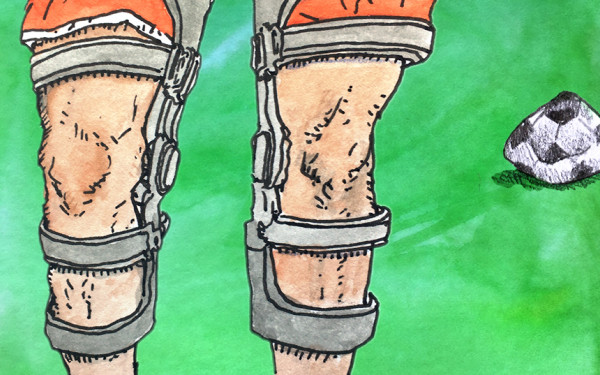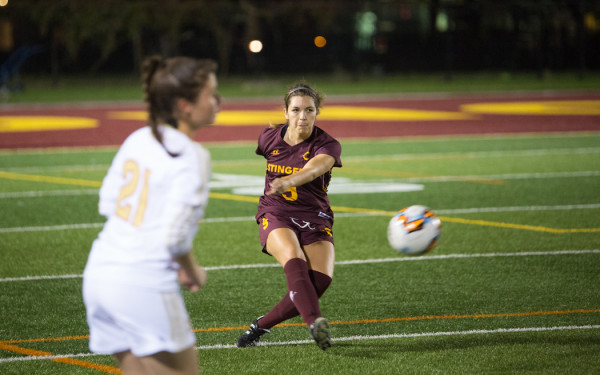Stephanie Di Lemme Returns to Stingers After Season-Ending Injury
Di Lemme Starts A Fresh Year After Missing 2015 Fall Season
It was a spring afternoon in March of 2015. The Concordia Stingers faced-off against the Université de Sherbrooke Vert et Or at the Stinger Dome. Concordia midfielder Stephanie Di Lemme left the field in disappointment, knowing that she was going to miss the following season.
“After the surgery it was very tough. Even before, at that last game of the second year, it was tough to know I wouldn’t see the field for another year,” said Di Lemme.
Di Lemme suffered a torn ligament in her shoulder while playing for Collège Lionel-Groulx Nordiques, causing it to often dislocate on impact.
During a game with the Nordiques, she fell to the ground and felt her shoulder pop. From there, the pain would be recurrent, causing her to be substituted in and out of games for the next two years.
Di Lemme played two seasons with the Stingers before getting surgery done on her shoulder. It was in her second year where the injury started to become a struggle.
“We were hoping she would’ve gotten it in the spring,” said Stingers head coach Jorge Sanchez. “By the time she got her surgery we knew that the fall season was a total write-off.”
After surgery, it took six months of recovery before Di Lemme could get back on the field with her team. She made the decision to get the operation done in July and miss the 2015 fall season in order to strengthen her shoulder.
“It was important to strengthen the shoulder,” said Sanchez. “The goal was really to ease her back in so that she can be totally ready this August.”
Missing six months was a hard pill to swallow. For the first four weeks Di Lemme had her arm attached in a splint. Her physical capabilities were temporarily limited, even the easiest of tasks proved to be difficult.
The injury was especially difficult for Di Lemme’s mother, Christine Langelier. Witnessing her daughter struggle was a painful sight.
“Of course at the beginning, she needed somebody to constantly help her. She couldn’t move. It was hard to eat, it was very painful,” said Langelier “For sure for me it was emotional.”
The three months post-surgery also proved frustrating for the Stingers midfielder.
“It was a good three months with no physical activity whatsoever. I was bored and missed the sport a lot,” said Di Lemme. “It was a pretty big injury so just doing normal things in the first three months was really rough.”
Throughout her rehabilitation, Di Lemme’s goal was clear: to play for the Stingers again. During her recovery, this became a source of motivation, spending a lot of time at the Concordia Stingers clinic.
Although she faced a lengthy spell on the sidelines, Di Lemme would occasionally make an appearance at Stingers practices. Di Lemme and Sanchez also managed to keep in touch. Her recovery and fitness surrounded most of their conversations.
“I think coach-player relationships can determine sometimes how connected you feel to a team,” said Di Lemme. “If you get injured and that’s the last time you hear [from the coach] it can be demotivating and you think you might not be a part of the team.”
Despite not being able to play, it was Di Lemme’s passion for her studies that proved promising throughout her recovery. Di Lemme is an exercise science major and interned as an Athletic Therapist on the Stingers men’s basketball team last season.
“I’ve always loved assisting someone for reaching a goal and it would help even more with what I was doing with the Stingers,” said Di Lemme. “It was very motivating. It was the reason why I chose athletic therapy.”
Her internship experience allowed her to develop a deeper connection with the Stingers.
“Although I couldn’t play with them, I was a part of the Stingers family in clinic, to see the players from all of the sports and always keeping contact with them,” said Di Lemme “I think that helped me stay connected in my rehab.”
Di Lemme’s return to the Stingers was a welcome one, especially from coach Sanchez. Her experience in Canadian Interuniversity Sport bodes well for Sanchez and his new Stingers team.
“It’s nice to get her back,” revealed Sanchez. “It’s like you get a bonus in recruiting, to get a player with a very specific profile that comes and is CIS ready.”
It’s her presence on the field that’s been missed, and that Sanchez is glad to see back on his team.
“She’s a very highly technical player, it’s something that we were sort of missing from that position last year,” said Sanchez. “She calms the play, she can distribute well from that defensive midfielder position as well as being a solid tackler on the defensive side of the ball.”
Di Lemme has wasted no time making her presence felt. In the first two league games of the season against the McGill Martlets and Université de Montréal Carabins, Di Lemme played the full 90 minutes. She also managed to cover 11 kilometres in both games, which proved to be the most out of any other player on the team—an astonishing feat for a player coming back from a long-term injury.
“She’s covering ground, she’s working hard, and doesn’t seem to be favouring her shoulder,” said Sanchez.
Di Lemme displayed a positive impression in her first two games, but Sanchez will still look to manage his returning player in order to avoid another injury.
“I don’t think it’s 100 per cent yet,” revealed Sanchez. “There’s probably some stiffness still there, but as far as I can see she’s fit.”
With the season up and running, and a healthy Di Lemme back in the squad, she will look to forget about her past injury woes, and help the Stingers make a push up the Réseau du Sport Étudiant du Québec.
Coming back from the injury, Di Lemme believes that she’s a better player now than before her operation. After spending two seasons playing with discomfort, she’s taking this opportunity in stride.
“It’s a fresh start. Also with the experience, with my first two years, I know the league, I know how it works so now it’s even better,” Di Lemme said.

2web_900_600_90.jpg)
web_900_600_90.jpg)
_600_832_s.png)


1_600_375_90_s_c1.jpg)
1_600_375_90_s_c1.jpg)
